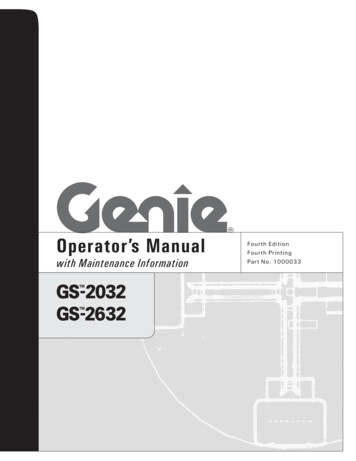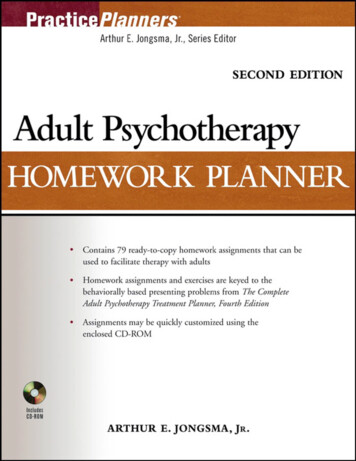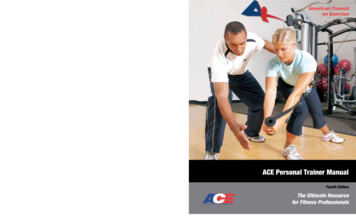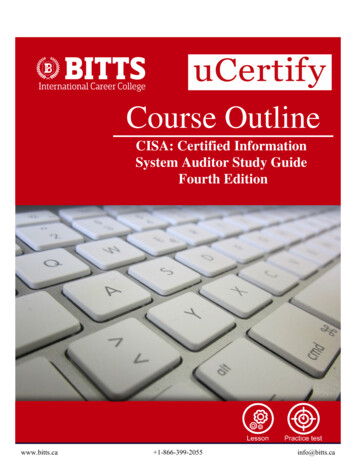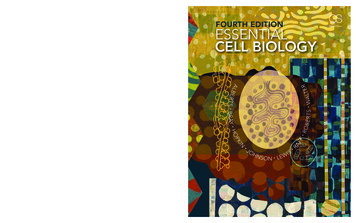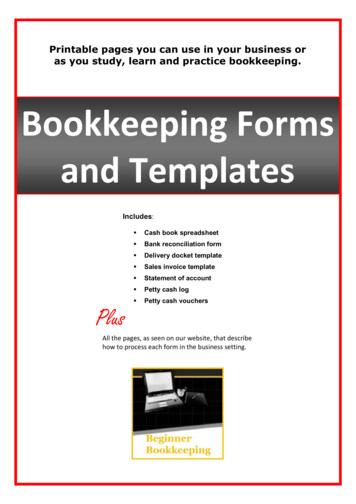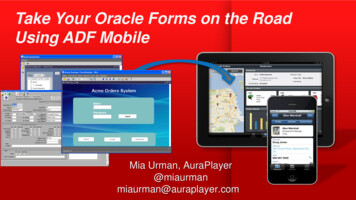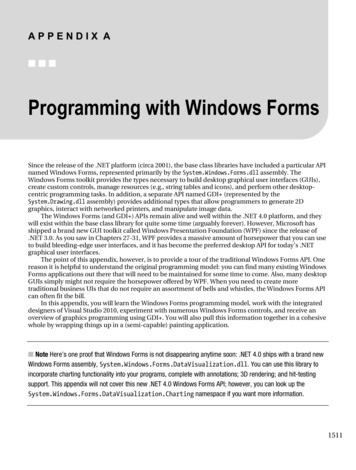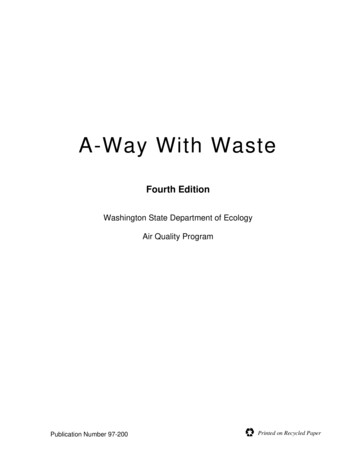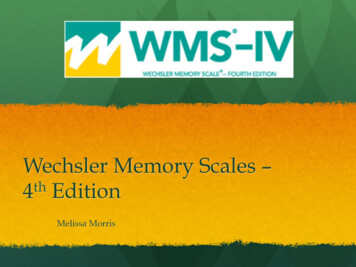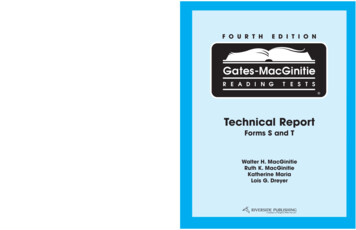
Transcription
F O U R T HE D I T I O NGMRTForms S and T GMRT Fourth Edition, Technical ReportTechnical ReportForms S and TWalter H. MacGinitieRuth K. MacGinitieKatherine MariaLois G. Dreyer9-40364
9-40364 GMRT Tech Man Cover IFC4/29/103:56 PMPage 1GATES-MACGINITIE READING TESTS (GMRT)Technical ReportWhat you will find in the manualsIn the Directions for AdministrationInformation about the Gates-MacGinitie Reading Tests seriesHow to choose appropriate test levelsWhat is in the testsWhat to do before testingHow to give the testsWhat to do if answer sheets will be scored by the Riverside Scoring Service In the Directions for Online AdministrationInformation about the Gates-MacGinitie Reading Tests seriesHow to choose appropriate test levelsWhat is in the testsHow to prepare for online testingHow to monitor the testingIn the Manual for Scoring and InterpretationHow to hand score the testsHow to use the tables of normsWhat the scores meanTables of 1999 and 2006 normsIn Linking Testing to Teaching:A Classroom Resource for Reading Assessment and InstructionHow to use the scores as part of a comprehensive assessment of readingHow to use the scores to guide instructionIn the Technical ReportHow the tests were developedHow the tests were standardizedStatistical information about the testsIn the Technical Report SupplementHow the tests were renormed in 2005–2006Statistical information about the renormingHow the online tests were developedStatistical information about the online testsCopyright 2002 by The Riverside Publishing Company. All rights reserved. No part of this work may be reproduced or transmitted in anyform or by any means, electronic or mechanical, including photocopying and recording, or by any information storage or retrieval systemwithout the prior written permission of The Riverside Publishing Company unless such copying is expressly permitted by federal copyrightlaw. Address inquiries to Permissions, Riverside Publishing, 3800 Golf Road, Suite 100, Rolling Meadows, IL 60008-4015.These tests contain questions that are to be used solely for testing purposes. No test items may be disclosed or used for any other reason. Byaccepting delivery of or using these tests, the recipient acknowledges responsibility for maintaining test security that is required byprofessional standards and applicable state and local policies and regulations governing proper use of tests and for complying with federalcopyright law which prohibits unauthorized reproduction and use of copyrighted test materials.7 8 9 10—RRD—12 11 10
9-40364 GMRT4 Tech RptADP 02-14-03TECHNICAL REPORTContentsTest Development . . . . . . . . . . . . . . . . . . . . . . . . . . . . . . . . . . . . . . . . . . . . . . . . . . .1Test Design . . . . . . . . . . . . . . . . . . . . . . . . . . . . . . . . . . . . . . . . . . . . . . . . . . . . . . . . . . . . . .1Pilot Studies . . . . . . . . . . . . . . . . . . . . . . . . . . . . . . . . . . . . . . . . . . . . . . . . . . . . . . . . .1Level PR (Pre-Reading) . . . . . . . . . . . . . . . . . . . . . . . . . . . . . . . . . . . . . . . . . . . . . . . .2Level BR (Beginning Reading) . . . . . . . . . . . . . . . . . . . . . . . . . . . . . . . . . . . . . . . . . .4Level AR (Adult Reading) . . . . . . . . . . . . . . . . . . . . . . . . . . . . . . . . . . . . . . . . . . . . . .6Word Decoding Tests . . . . . . . . . . . . . . . . . . . . . . . . . . . . . . . . . . . . . . . . . . . . . . . . . . .6Word Knowledge and Vocabulary Tests . . . . . . . . . . . . . . . . . . . . . . . . . . . . . . . . . . . .9Comprehension Tests . . . . . . . . . . . . . . . . . . . . . . . . . . . . . . . . . . . . . . . . . . . . . . . . .16Question Difficulty . . . . . . . . . . . . . . . . . . . . . . . . . . . . . . . . . . . . . . . . . . . . . . . . . . .27Cultural Diversity . . . . . . . . . . . . . . . . . . . . . . . . . . . . . . . . . . . . . . . . . . . . . . . . . . . . . . .29Bias Review . . . . . . . . . . . . . . . . . . . . . . . . . . . . . . . . . . . . . . . . . . . . . . . . . . . . . . . . .29Statistical Bias Analysis (Differential Item Functioning) . . . . . . . . . . . . . . . . . . . .30Diversity of Content . . . . . . . . . . . . . . . . . . . . . . . . . . . . . . . . . . . . . . . . . . . . . . . . . .32Answer Media . . . . . . . . . . . . . . . . . . . . . . . . . . . . . . . . . . . . . . . . . . . . . . . . . . . . . . . . . . .32Field Testing . . . . . . . . . . . . . . . . . . . . . . . . . . . . . . . . . . . . . . . . . . . . . . . . . . . . . . . . . . . .32Field-Test Edition . . . . . . . . . . . . . . . . . . . . . . . . . . . . . . . . . . . . . . . . . . . . . . . . . . . .32Field-Test Administration . . . . . . . . . . . . . . . . . . . . . . . . . . . . . . . . . . . . . . . . . . . . .33Analysis of Field-Test Question Data . . . . . . . . . . . . . . . . . . . . . . . . . . . . . . . . . . . .35Analysis of Field-Test Administration Time . . . . . . . . . . . . . . . . . . . . . . . . . . . . . . .36Question Selection . . . . . . . . . . . . . . . . . . . . . . . . . . . . . . . . . . . . . . . . . . . . . . . . . . . . . . .38Levels PR and BR . . . . . . . . . . . . . . . . . . . . . . . . . . . . . . . . . . . . . . . . . . . . . . . . . . . .38Levels 1 and 2 Word Decoding . . . . . . . . . . . . . . . . . . . . . . . . . . . . . . . . . . . . . . . . . .39Level 2 Word Knowledge and Levels 3–10/12 and AR Vocabulary . . . . . . . . . . . . .39Levels 1–10/12 and AR Comprehension . . . . . . . . . . . . . . . . . . . . . . . . . . . . . . . . . .40Question Sequence . . . . . . . . . . . . . . . . . . . . . . . . . . . . . . . . . . . . . . . . . . . . . . . . . . . . . . .41Standardization . . . . . . . . . . . . . . . . . . . . . . . . . . . . . . . . . . . . . . . . . . . . . . . . . . .43Sample Selection . . . . . . . . . . . . . . . . . . . . . . . . . . . . . . . . . . . . . . . . . . . . . . . . . . . . . . . .43Levels PR through 10/12 . . . . . . . . . . . . . . . . . . . . . . . . . . . . . . . . . . . . . . . . . . . . . .43Level AR . . . . . . . . . . . . . . . . . . . . . . . . . . . . . . . . . . . . . . . . . . . . . . . . . . . . . . . . . . . . . . .45Equating Studies . . . . . . . . . . . . . . . . . . . . . . . . . . . . . . . . . . . . . . . . . . . . . . . . . . . . . . . .46Equating of Levels . . . . . . . . . . . . . . . . . . . . . . . . . . . . . . . . . . . . . . . . . . . . . . . . . . .46Equating of Third and Fourth Editions . . . . . . . . . . . . . . . . . . . . . . . . . . . . . . . . . .48Equating of Forms . . . . . . . . . . . . . . . . . . . . . . . . . . . . . . . . . . . . . . . . . . . . . . . . . . .50
Norms Development . . . . . . . . . . . . . . . . . . . . . . . . . . . . . . . . . . . . . . . . . . . . . . . . . . . . . .51Test Characteristics . . . . . . . . . . . . . . . . . . . . . . . . . . . . . . . . . . . . . . . . . . . . . . . .53Item Difficulty . . . . . . . . . . . . . . . . . . . . . . . . . . . . . . . . . . . . . . . . . . . . . . . . . . . . . . . . . .53Reliability . . . . . . . . . . . . . . . . . . . . . . . . . . . . . . . . . . . . . . . . . . . . . . . . . . . . . . . . . . . . . .53Reliability Indices and Standard Errors of Measurement . . . . . . . . . . . . . . . . . . . .53Correlations among Tests . . . . . . . . . . . . . . . . . . . . . . . . . . . . . . . . . . . . . . . . . . . . . .60Stability of Scores: Fall-Spring Correlations . . . . . . . . . . . . . . . . . . . . . . . . . . . . . .62Validity . . . . . . . . . . . . . . . . . . . . . . . . . . . . . . . . . . . . . . . . . . . . . . . . . . . . . . . . . . . . . . . .64Completion Rates . . . . . . . . . . . . . . . . . . . . . . . . . . . . . . . . . . . . . . . . . . . . . . . . . . . .64Ceiling and Floor Data . . . . . . . . . . . . . . . . . . . . . . . . . . . . . . . . . . . . . . . . . . . . . . .65Contributions of Test Design and Development . . . . . . . . . . . . . . . . . . . . . . . . . . . .70Test Design . . . . . . . . . . . . . . . . . . . . . . . . . . . . . . . . . . . . . . . . . . . . . . . . . . . . . . . . . . .70Cultural Diversity . . . . . . . . . . . . . . . . . . . . . . . . . . . . . . . . . . . . . . . . . . . . . . . . . . . . . .74Field Testing . . . . . . . . . . . . . . . . . . . . . . . . . . . . . . . . . . . . . . . . . . . . . . . . . . . . . . . . . .74Question Selection . . . . . . . . . . . . . . . . . . . . . . . . . . . . . . . . . . . . . . . . . . . . . . . . . . . . . .75Other Evidence of Validity . . . . . . . . . . . . . . . . . . . . . . . . . . . . . . . . . . . . . . . . . . . . .76Correlations with Other Reading Tests . . . . . . . . . . . . . . . . . . . . . . . . . . . . . . . . . . . . .76Correlations with Course Grades . . . . . . . . . . . . . . . . . . . . . . . . . . . . . . . . . . . . . . . . . .77References and Notes . . . . . . . . . . . . . . . . . . . . . . . . . . . . . . . . . . . . . . . . . . . . . .78Appendices . . . . . . . . . . . . . . . . . . . . . . . . . . . . . . . . . . . . . . . . . . . . . . . . . . . . . . . .86Appendix A: Characteristics of Comprehension Passages . . . . . . . . . . . . . . . . . . . . . . . .86Appendix B: Schools Participating in the Standardization 89of Levels PR through 10/12 . . . . . . . . . . . . . . . . . . . . . . . . . . . . . . . . . . . . . . . . . . . . . .89Appendix C: Schools Participating in the Equating Studies . . . . . . . . . . . . . . . . . . . . . .97Appendix D: Community Colleges Participating in theStandardization of Level AR . . . . . . . . . . . . . . . . . . . . . . . . . . . . . . . . . . . . . . . . . . . .102Appendix E: Standardization Questionnaire . . . . . . . . . . . . . . . . . . . . . . . . . . . . . . . . .104Appendix F: Item Difficulties . . . . . . . . . . . . . . . . . . . . . . . . . . . . . . . . . . . . . . . . . . . . .105
9-40364 GMRT4 Tech RptADP 02-14-03TEST DEVELOPMENTTest DesignDevelopment of the Fourth Edition of the Gates-MacGinitie Reading Tests (GMRT ) was guided by a detailed description, or blueprint, specifying the testcontent and desired difficulty for each level. The blueprint for the Fourth Editionis similar to the one for the Third Edition. However, some changes were made forthe Fourth Edition, particularly in the lower test levels in which subtests wereadded or substituted. These changes and the reasons for them are discussed inthe sections that follow. In these sections, also, a number of references are madeto information obtained from the “field test.” These are references to the extensivefield testing of test materials prior to the selection of test questions for the finaltest forms. See the sections “Field Testing,” beginning on page 32, and “QuestionSelection,” beginning on page 38, for a description of this field testing and theways in which the obtained data were used in test development.Pilot StudiesSeveral tests and subtests were new for the Fourth Edition at Levels PR(Pre-Reading), BR (Beginning Reading), 1, and 2. The new tests and subtestsinvolved either formats or types of content that had not been used in earliereditions. The authors needed to know if the new formats were easy for thestudents to follow, if the new content was appropriate in maturity and difficulty,and how much time was needed to administer the new tests. Pilot studies of thenew tests for Levels PR, 1, and 2 were conducted in April of 1995. Classes fromall parts of the country participated in the studies—22 classes at Kindergarten,22 at Grade 1, and 21 at Grade 2. Teachers of these classes were generally pleasedwith the new tests, and the teachers’ comments were very helpful in improvingthe tests and their administration. Test authors administered the pilot tests infour of the schools. The students’ scores and data about the questions and thetime needed to administer the tests in all the pilot schools were analyzed toprovide guidance in developing the field-test forms.A pilot testing on a smaller scale was carried out with the Basic Story Wordssubtest of Level BR in June of 1995 and again in May of 1996. Both testingsinvolved a total of eight Grade 1 classes in three schools in Eastern states. Thesepilot tests were all administered by one or another of the test authors.1
9-40364 GMRT4 Tech RptADP 02-14-03The pilot studies were used not only to find out how difficult the questions shouldbe and how much time they required, but also to answer such fundamental andvitally important questions as䉬 Whether students had difficulty keeping the place;䉬 Whether the wording of the directions to the students was clear;䉬 Whether the directions were unnecessarily long;䉬 Whether the students understood where to look for the answer choices;䉬 When best to tell the students to put their pencils down.These kinds of information were important to the authors because their aim wasto develop a test in which the essential information was tested in a way thatallowed the students to do their best. The authors’ experiences had made clear tothem that even the most knowledgeable adult may not know which wordings andpage arrangements may cause the students unforeseen difficulties inunderstanding a task.Level PR (Pre-Reading)Changes from the Third EditionLevel PR (Pre-Reading) in the Fourth Edition replaces Level PRE of the ThirdEdition. In Level PR, Listening (Story) Comprehension is a new subtest for theFourth Edition. The purpose of including this new subtest is to provide aprogression of instruments to measure the development of comprehension1. From listening to stories in Level PR;2. Through reading Basic Story Words in context in Level BR;3. To reading simple illustrated stories in Levels 1 and 2;4. To reading progressively more advanced selections from published works inLevels 3 through 10/12.Listening (Story) Comprehension is included in Level PR because the authorsbelieve that students’ experience in attending to important elements in a story,integrating information from different parts of a story, making inferences aboutstory developments, and generally becoming engaged with oral text are criticalcomponents of the students’ background for reading instruction.1 The format ofthis new test is similar to that of the new format of the Comprehension tests ofLevels 1 and 2. (See the section “Format of Levels 1 and 2,” on page 16.) Theteacher reads each story to the students. The story is read in five segments, andeach segment is associated with a row of three pictures. The student’s task is tochoose the picture in each row that goes with the story. A small silhouette by eachrow of pictures helps the students attend to the proper row.2
9-40364 GMRT4 Tech RptADP 02-14-03The format and sample stories of the Listening (Story) Comprehension subtestwere evaluated in the pilot study described above. The results of the pilot studyshowed that the format the authors had developed was suitable for children atthe end of Kindergarten and the beginning of Grade 1.To permit the addition of the Listening (Story) Comprehension subtest withoutlengthening testing time, the types of background assessed by two Third Editionsubtests—Literacy Concepts and Reading Instruction Relational Concepts—areassessed in the Fourth Edition in a single subtest: Literacy Concepts. Bydeveloping questions that focus on essential elements of these areas, the authorscould provide a sensitive test of them with fewer total questions but higherreliability.The other two subtests of Level PR—Oral Language Concepts (PhonologicalAwareness) and Letters and Letter-Sound Correspondences—are very similar tothe corresponding subtests in the Third Edition. One change in the OralLanguage Concepts subtest was that questions testing how well students canidentify words that rhyme replaced questions that tested phoneme deletion. Asstudents develop phonological awareness, the ability to recognize when two wordsrhyme generally precedes the ability to segment a word into phonemes.2 Thechange from testing phoneme deletion to testing rhyme was made so thatteachers might know when a student has difficulty with this early aspect ofphonological awareness. Being alerted to such a difficulty allows the teacher toprovide guidance and support that may help the student become aware of rhymeand also develop other aspects of phonological awareness.Design of Level PRA blueprint for the final form of Level PR specified the number of questions to beincluded in the first three subtests—Literacy Concepts, Oral Language Concepts(Phonological Awareness), and Letters and Letter-Sound Correspondences. Forthe field test, a larger number of question types was included in each of thesethree subtests than was to be included in the final test. For example, in one typeof question used in the field test, the student’s task was to select the short stringof printed letters that looked most like a real word. This task was based onresearch on students’ developing intuitions about letter patterns. However,because the field test showed that several questions of that type were difficultand evidently confusing, that type of question was not used in the published test.The design of question types and of individual questions was also guided in partby an analysis that had been done as part of the field-test data analysis for LevelPRE of the Third Edition. That analysis is described in the section “Field-TestData Analysis” on pages 15–16 of the Technical Report for the Third Edition.3On some of the pages of Level PR, each question begins with a picture in a square.By naming these pictures, the teacher can help make sure the students areworking at the right place. On pages without these pictures, a small silhouettewith an easily recognized outline and a familiar name (e.g., “star,” “tree”) is placednext to each question. The silhouettes differ from question to question, and nosilhouette is repeated within any two-page spread. By using the names of the3
9-40364 GMRT4 Tech RptADP 02-14-03silhouettes, the teacher can guide the students’ progress down the test page. Thesilhouettes were carefully chosen to avoid cueing any of the answer choices eitherby sight or by sound.While estimates of the time needed to administer the questions for the newListening (Story) Comprehension subtest were obtained from the pilot test, thenumber of questions to be included in this subtest was left to be determinedby data from the larger, national student sample taking the field test. The20-question length tentatively selected on the basis of the pilot testing—fivequestions in each of four stories—proved to be appropriate, since the field-testdata showed that a 20-question test would䉬 Take about the right length of time to administer;䉬 Be suitably reliable.Level BR (Beginning Reading)Changes from the Third EditionLevel BR (Beginning Reading) in the Fourth Edition replaces Level R of the ThirdEdition. In Level BR, the Basic Story Words subtest replaces the Use of SentenceContext subtest of the Third Edition Level R. The Basic Story Words subtest wasintroduced as part of the developmental sequence for assessing the growth ofcomprehension, from the Listening (Story) Comprehension subtest of Level PR tothe reading comprehension tests at higher levels. The format and representativestories of the Basic Story Words subtest were evaluated in the pilot studydescribed above.The Basic Story Words subtest is designed to measure how well the student canread a sample of essential words that appear very frequently in stories forchildren, and, in fact, in all text. It is generally agreed that knowledge of suchwords (many of which are often taught as “sight words”) is a critical aspect ofbeginning reading development.4 The tested words are embedded in thesentences of simple stories that were written to provide meaningful context forthe “story words.” The teacher reads each sentence, including the “story word.”The student must then choose, from among four printed words, the “story word”that the teacher has read.The words tested in the Basic Story Words subtest were selected from either the“Dolch List”5 or the “Revised Dolch List.”6 The other words in the sentences ofthese stories were also selected from these lists, with the restriction that notested word could be used elsewhere in any of the story sentences. This restrictionwas included so that students could not learn to recognize a right answer byhaving it read to them in the context of one of the other questions during thetesting.4
9-40364 GMRT4 Tech RptADP 02-14-03Design of Level BRFor Level BR, the blueprint for the final test specified the number of questions tobe included in each of the four subtests:䉬 Letter-Sound Correspondences: Initial Consonants and Consonant Clusters;䉬 Letter-Sound Correspondences: Final Consonants and Consonant Clusters;䉬 Letter-Sound Correspondences: Vowels;䉬 Basic Story Words.For the first three subtests, the number of questions using each of two differentformats was also specified. The grouping of letter-sound correspondencesquestions into subtests followed the pattern of the Third Edition. An analysis ofvarious possible groupings for the Third Edition suggested that the groupinglisted above would be most helpful as a basis for providing further instruction.(See pages 17–18 of the Technical Report for the Third Edition.7) To ensure theirappropriateness, the selected letter-sound correspondences were checked againsta list of skills taught in twenty-one reading programs.8Following the design of the Third Edition, the three tests of letter-soundcorrespondences are administered in only two testing sessions. The total timerequired for administering any test includes not only the time students spendworking on the test, but also the time spent in organizing the room, passing outthe test materials, giving directions, and collecting the test materials. Therefore,combining the three subtests in two testing sessions saves considerable total timein administering Level BR. This arrangement is possible, since䉬 The question formats of the three subtests are sufficiently similar that thetransition from one subtest to another does not require additionalinstructions to the students;䉬 The good reliability of the subtests means that they can be short enoughthat part of the third subtest can be administered with each of the other twoin a testing session of reasonable length.The administration of three subtests in only two sessions makes the scoring of thesubtests slightly less convenient, but the total time saved—especially thestudents’ time—is considerable.As in Level PR, small silhouettes with familiar shapes and names were used forhelping the students keep the place. For the letter-sound correspondencesquestions of Level BR, particular care was necessary to ensure that the sounds inthe name of a silhouette do not cue any of the answer choices for thecorresponding question.5
9-40364 GMRT4 Tech RptADP 02-14-03Level AR (Adult Reading)Level AR is an entirely new test level for the Fourth Edition. The purpose of LevelAR is to provide community colleges and training programs with a reading testthat, in concert with other assessment, can help locate students in need ofimproved reading skills. If such students can be located, they can usually behelped to develop their reading skills, giving them a better opportunity to besuccessful in their regular classes. Norms for Level AR were therefore desiredthat would reflect the range of reading skill typical of students enteringcommunity college—or training programs at that level. For that reason, norms forLevel AR were obtained only at one time of year—in the fall, when the majorityof community college students first enter.After informal consultation with several community college programs, it wasdetermined that Level AR should include a wide range of question difficulty andthat the average question difficulty should be between that of Level 7/9 and thatof Level 10/12. Thus, Level AR is not a further step in the progression of tests forthe regular school grades.The general structure of the tests for Levels 3 through 10/12 seemed suitable forLevel AR. Indeed, some community colleges had been using Level 7/9 of the ThirdEdition for screening entering students. These community colleges had evidentlyfound the general structure of Level 7/9 suitable, but wished that the range ofquestion difficulty was wider and that the content of the Comprehensionpassages was somewhat more mature. Thus, Level AR is designed with the samestructure as Levels 3 through 10/12 but the selection of Comprehension passagesis designed to be suitable for young adults.Word Decoding TestsThe Word Decoding tests for Levels 1 and 2 in the Fourth Edition have the sameformat as the Vocabulary tests for these levels in the Third Edition. These FourthEdition tests are called “Word Decoding” for two reasons:䉬 To distinguish them from the new Word Knowledge test of Level 2䉬 To emphasize that the test format and the tested words measure primarilydecoding skills and word identification, rather than knowledge of wordmeanings.Selection of Test WordsTest words for the Word Decoding tests for Levels 1 and 2 are words that䉬 Were judged by the authors to be words that nearly all students in the gradefor which the test level was designed would be likely to know in speech.䉬 Are commonly used in reading materials for Grade 3 or lower.96
9-40364 GMRT4 Tech RptADP 02-14-03䉬 Follow common orthographic rules as exemplified by the letter-soundcorrespondence skills commonly taught in reading programs.10䉬 Comprise common orthographic patterns that permit the test word to becontrasted with wrong answer choices that are similar in spelling, so thatchoosing the correct answers depends on using specific decoding skills.None of the Word Decoding test words selected for field testing in the FourthEdition had been used in the Third Edition.Selection of Wrong Answer ChoicesWrong answer words were chosen so that each one was similar to the test wordbut differed from it in some significant way so that, when pronounced usingcommon letter-sound correspondences, it would clearly be a different word fromthe test word. Thus, the spelling of the wrong answer and the test word might bejust the same except for one different consonant or vowel letter or except for anadded or omitted letter. For example, one of the practice questions for the WordDecoding test shows a picture of a hat, and the wrong answer choices are hot, hit,and hut. All answer choices are real words; no nonsense words are used.A wrong answer word did not have to be as familiar as the test word, as long asits pronunciation would make it clearly wrong for a student who can read the testword by using the decoding skill that distinguishes the test word from the wronganswer. Homophones of test words were not used as wrong answers.Pictures for Representing Test WordsSpecifications were written for each of the pictures depicting the correct answerwords. These specifications were used by the illustrators to guide their work.Several guidelines were established for preparing these specifications. Theguidelines were intended to ensure that the specifications would lead theillustrators to draw pictures that䉬 Picture the most common version or style of the object or action (whateverwould be most recognizable to students all across the country);䉬 Focus on the named object or action:䉴The view chosen should make the object or action evident,䉴The object or action should be as large as possible in the picture space,䉴Other objects or actions inherent in the picture should be de-emphasized;䉬 Show only what is necessary to communicate the object or action clearly(Unnecessary detail, background, or shading can reduce the clarity withwhich the object or action is depicted.);7
9-40364 GMRT4 Tech RptADP 02-14-03䉬 Ensure that nothing in the picture could reasonably be interpreted as anillustration of one of the wrong answer words;䉬 Picture whole objects (Pictures of parts of objects tend to be difficult tointerpret and should be used only when showing an entire object is notpossible or when providing context for an action.).These guidelines were followed in creating specifications for each picture. Thespecifications were given to an illustrator, and the resulting pencil drawings werecritiqued by the authors and often were then changed or redrawn. Once the pencildrawings were approved by the authors, they were inked in by the illustrator andthen examined again by the authors.Decoding Skills Analysis Forms and ReportsTo increase the usefulness of the Word Decoding scores, a Decoding SkillsAnalysis Form and a Decoding Skills Analysis Report were developed for each ofthe three Word Decoding tests. Decoding Skills Analysis Forms are filled out bythe teacher. Decoding Skills Analysis Reports are available as a separate servicefor tests that are scored by the Riverside Scoring Service . Both the DecodingSkills Analysis Forms and the Decoding Skills Analysis Reports show, for eachWord Decoding question, the decoding skill that a student who chose a wronganswer may not know.The three wrong words for each Word Decoding question look and sound muchlike the correct word, so that selecting the correct word ordinarily requiresknowing the sound that corresponds to a tested letter or letter sequence. Thelisted skills were determined by comparing each wrong answer with the correctanswer and noting the crucial difference between the two similar words. Whenmore than one skill is involved in choosing the correct over an incorrect answer,the skill listed is the one that was considered to be primary in importance—theone that, if not known, suggests the most serious problem in decoding. In general,if a wrong answer choice suggests that the student does not know a skill that isusually learned early and well by most beginning readers, that error wasconsidered more serious than an error involving a skill that is usually learne
content and desired difficulty for each level. The blueprint for the Fourth Edition is similar to the one for the Third Edition. However, some changes were made for the Fourth Edition, particularly in the lower test levels in which subtests were added or substituted. These changes and the reasons for them are discussed in the sections that follow.
